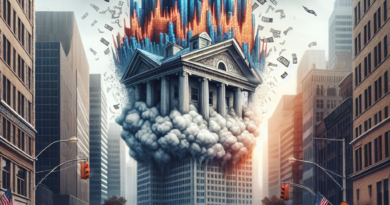What if the Stock Market Troubles are Just Beginning?
The Recent Upsurge in the Stock Market
In recent days, the stock market has shown signs of recovery, notably highlighted by the upward trend of the S&P 500, which has recorded gains in the last few sessions.
Graphically, it appears that a bottom has been reached, and the causes that led to the collapse have either dissipated or never existed.
Many analysts have supported this view, attributing it to a repetition of past patterns often explained by a kind of collective “mass hysteria.”
However, some of the factors that seemed to underlie the recent market downturn have not been addressed at all.
Faced with this situation, the market stands at a crossroads: if the causes of the decline were real, the problems could persist; if they were instead “exaggerated,” leading to a sort of hysteria, then a recovery towards highs could be expected.
The answer to this question is by no means simple; let’s analyze the data to better understand.
What Caused the Decline of the S&P 500 in Recent Weeks?
One of the main reasons behind the S&P 500’s decline was the rise in the unemployment rate, triggering the “Sahm rule,” an economic indicator signaling a potential start of a recession when unemployment increases rapidly.
The Sahm rule activates when the unemployment rate exceeds the 12-month moving average by at least 0.5 percentage points.
This indicator was very relevant during the 2008 crisis when the unemployment rate jumped from 5% to 10% in just over a year.
In the United States, the recent surge in unemployment claims has been partly attributed to the consequences of natural disasters, such as Hurricane Beryl in Texas.
This caused significant disruptions in economic activities, leading to a temporary increase in unemployment benefit claims.
This, in part, allayed investors’ concerns about an upcoming financial armageddon.
Similarly, subsequent labor market data, like unemployment benefit claims, showed improvement, fostering renewed market confidence.
This raised hopes that the rise in the unemployment rate was only a temporary anomaly and not a sign of a deeper crisis, contributing to the current (mini) recovery of the S&P 500.
Interest Rates and the Fed’s Uncertainty
The market is now eagerly awaiting new rate cuts, with many traders even calling for early cuts before the September FOMC meeting.
Not surprisingly, another element that has boosted the stock market’s confidence in the economy is the belief that the Fed will lower rates to support the market (almost certainly).
However, what would happen if the Fed did not cut rates or worse, signaled a reluctance to implement the five expected rate cuts by the end of 2025, as priced into the bond market?
This is not an option to be ruled out, even if the stock market seems to have excluded it from the alternatives.
Until recently, there was talk of a “no landing,” with an economy so resilient that a new inflation surge could not be ruled out.
What will the Fed do in this scenario? Fed officials do not all agree on the cuts: Governor Michelle Bowman has expressed concerns about the inflation situation.
The upcoming release of the July consumer price index could significantly shake the markets, especially if it confirms predictions of a 3% increase from the previous year and a 0.2% increase from the previous month.
Moreover, the recent massive sell-off of Treasuries, as demonstrated by Meta Platforms’ sale of $10.5 billion in bonds, raises further questions.
How can this rush to sell investment-grade bonds be justified in a context expecting a soft landing and rate cuts?
The Role of Carry Trade and Morgan Stanley’s View
Another reason behind the recent market collapse is the issue of carry trade.
Carry trade is a financial strategy where investors borrow money in a low-interest currency to invest in another currency with a higher interest rate, aiming to profit from the difference.
However, the increased volatility in the currency markets has spooked investors, leading to a sell-off that heavily impacted the stock markets.
Morgan Stanley has offered an interesting perspective on this matter, suggesting that behind the recent volatility lies much more than the mere fact that some investors got trapped in a currency bet.
According to the investment bank, the cooling of enthusiasm for artificial intelligence-related securities, which started well before the conclusion of the carry trade, may have played a significant role in the recent collapse.
Recession and the Redefinition of Valuation Multiples
At the heart of market concerns lies the possibility of a recession but also the risk of a redefinition of tech companies’ valuation multiples.
The market has priced in with certainty a soft landing, a slowing down of the economy without a significant recession.
However, not only might this scenario not materialize, but the Fed does not seem ready to cut rates as expected by the bond market.
This uncertainty fuels market fear, as evidenced by the increase in the VIX, the volatility index, approaching levels seen during the 2008 crisis and the pandemic.
This indicates how a financial “armageddon” could negatively influence the markets in this historical moment.




